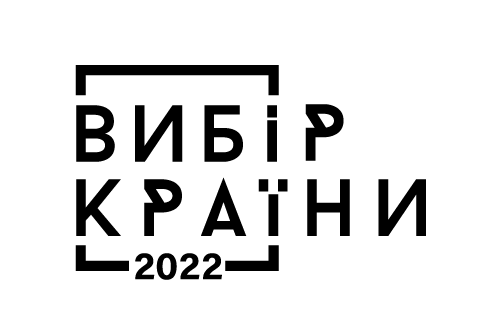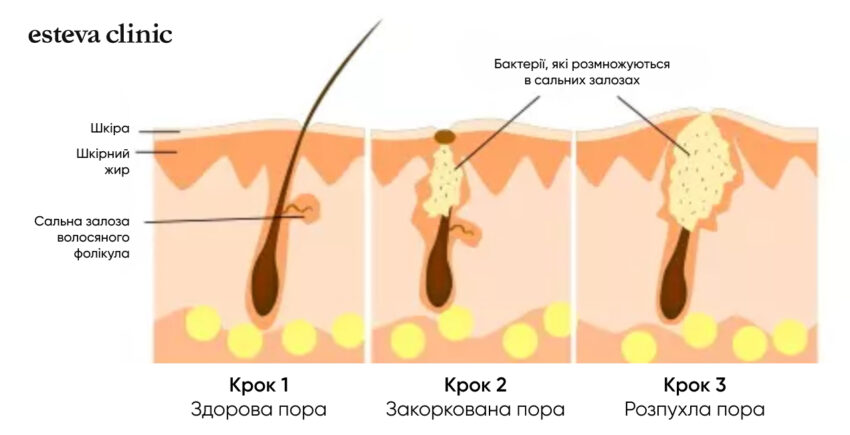Acne: what it is, types, causes, how to treat
The term “acne” is well known to many, but not everyone fully understands what it is.
Acne (or acne) is a widespread, chronic skin condition. It is also known colloquially as acne.
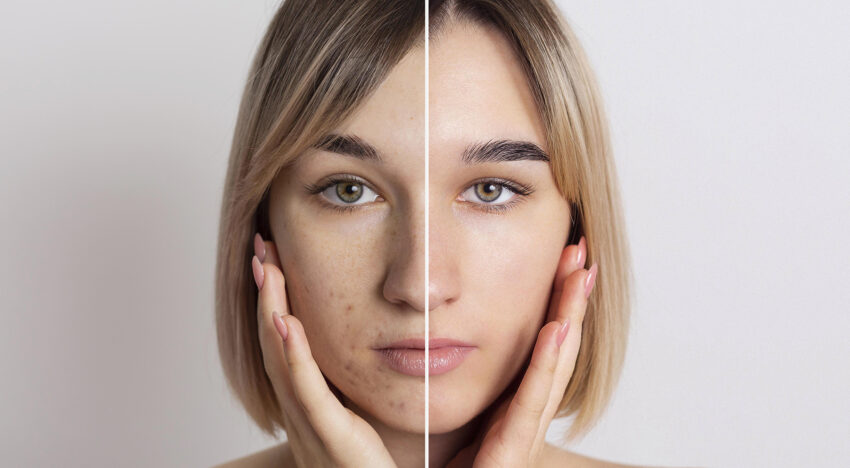
In this article, we will consider in detail what this disease is, why it appears, how it can be cured and effectively get rid of the consequences of rashes.
What is acne
With acne, rashes on the skin are chronic and inflammatory in nature. Although in most cases such rashes on the skin pass on their own and without a trace, sometimes scars or dark spots appear in their place – postacne. intense rashes can become not only a cosmetic problem, because self-esteem often decreases due to such changes in appearance. Sometimes it even leads to depression. But the correct treatment of acne will help to avoid dermatological, aesthetic and psychological difficulties.
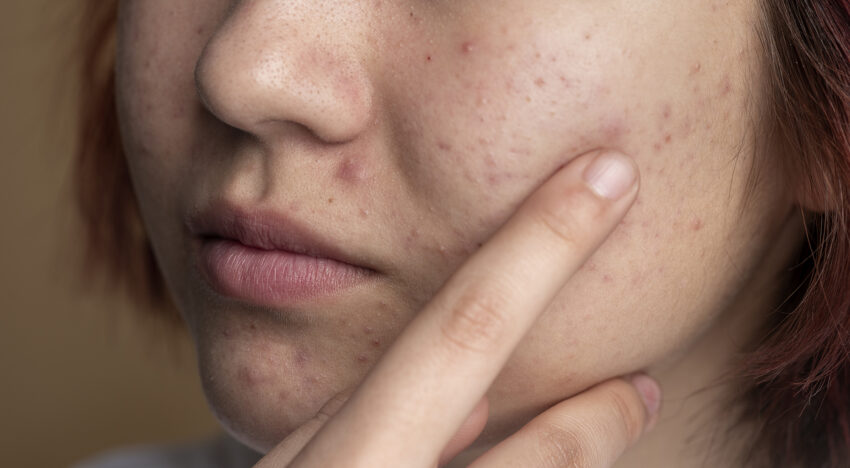
Pimples appear mainly in teenagers: 85% of boys and girls from 12 to 25 years old have acne rashes. Over time, this problem becomes less relevant: only 11% of people older than this age continue to have acne periodically. The reason lies in the hormonal background, which actively changes during puberty: the amount of androgen hormones, including testosterone, increases significantly. Contrary to popular belief, the female body also produces testosterone – it is this that leads to the formation of rashes.
What does acne look like
Visually, this is a seal protruding above the surface of the skin. Acne appears on any part of the body, but the most vulnerable areas are the face, neck, chest, and upper back. Acne is formed due to blockage of the sebaceous ducts, which are most common in the areas listed above. Some formations are visually difficult to distinguish, others (larger) are clearly visible.
Types of rashes and skin problems with acne:
- Open comedones (blackheads) are made up of excess oil, bacteria and dead cells. It is these accumulations that are contained in the dark “filling” of a pimple, and not dirt, as is sometimes thought.
- Closed comedones (whiteheads) are bulging formations that preserve the integrity of the surface, so the accumulation of fat, bacteria and skin cells remains under a thin layer of the dermis and has a white color.
- Pustules are similar to whiteheads, but with redness around the base. Pustules can leave scars, so they must be treated immediately.
- Papules are bulging formations of pink or red color, accompanied by inflammation of varying intensity.
- Cysts are pus-filled formations that can also leave scars.
- Nodule (knots) are formations in the thickness of the skin, which have a dense structure, cause discomfort and pain.
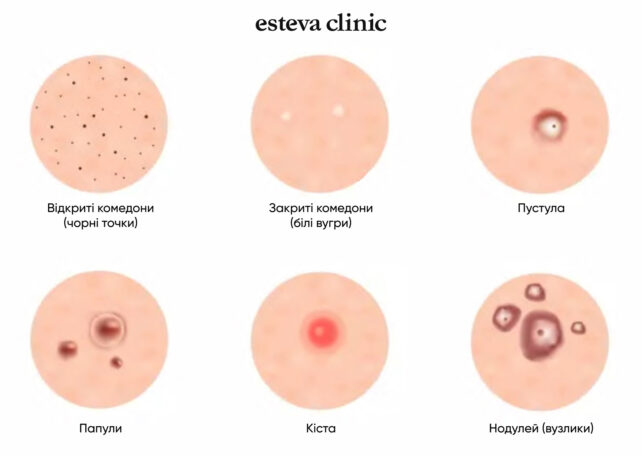
Acne can appear alone or in groups, form and disappear imperceptibly or be accompanied by uncomfortable sensations. There are 4 stages of acne:
- Light – a small number of small single acne.
- Average – more rashes, some have signs of inflammation.
- Severe – there are many rashes, most of them with inflammation, nodes or cysts are formed.
- Very severe – a high concentration of acne of one or more types, many of them painful.
Acne of the first and second degree is treated quite quickly. But if you have any type of acne (or a combination of several types), you should consult a dermatologist who will choose a treatment regimen. You can treat a rash at any stage, but if you start earlier, the result will be much better.
Causes of acne
Before starting treatment, it is important to understand what causes the rash on the body. The main reasons:
- Oily skin type – too active work of the sebaceous glands produces a large amount of secretion, the skin does not have time to self-cleanse.
- Follicular hyperkeratosis – the follicular ducts are closed by a thin layer of the horny layer of the skin, which leads to the formation of comedones.
- Bacteria Propionbacterium acne – they live on the body of most people and often do not cause problems. But an increase in their number leads to the appearance of rashes.
- Inflammation of the skin – it can be provoked by numerous factors.
How to properly treat acne
There are a large number of modern methods of acne treatment that will give good results. We talked about the most effective methods against rashes and their consequences in the video.
When seeking treatment, it is important to be realistic – this is not a one-day task. There are a lot of false claims about acne treatment. Here are five facts to keep in mind:
◼ There is no quick cure for acne. More precisely, quickly and efficiently. It takes time (from 4 to 8 weeks) to see the effect. The result overnight or the use of miracle drugs is, unfortunately, impossible!
◼ Treatment will help get rid of existing acne faster. But its main purpose is to prevent the appearance of rashes in the future.
◼ For a sustainable result, it is important to follow the dermatologist’s recommendations even if the skin has already visually cleared.
◼ Disappearing, inflamed pimples sometimes leave dark flat spots (not scars) that disappear after a few months.
◼ You can’t squeeze, shovel, squeeze or pick pimples – that’s what causes scars.
Correct medicineAcne treatment begins with a comprehensive examination and skin care in the doctor’s office. A cometologist can give you a facial cleaning or a course of peelings, if the condition of the skin allows it. In addition, the doctor selects home care products based on the condition of the skin and the degree of damage.
How to care for skin with acne
For the successful treatment of acne, it is necessary to follow a comprehensive treatment regimen. This will allow to influence the body comprehensively – both externally and internally. What helps with acne:
◼ exfoliation or acid peels;
◼ use of means containing antibiotics;
◼ acne treatment with phototherapy;
◼ in certain cases, hormone therapy;
◼ correction of the diet.
After assessing the situation, the doctor will determine how to get rid of acne most effectively. Skin care requires time and effort, but the result will really be there, and it will be long-lasting.
Results of acne treatment by Esteva Clinic specialists:
Complications from acne
The most unpleasant complication after rashes is postacne. This is called a complex change of the skin area. Acne marks on the face and body appear due to the lack of treatment or due to the choice of the wrong method.
Postakne is:
◼ Enlarged pores. In a normal state, the human skin cleans itself of dead particles. But with acne, these particles of the epidermis remain on the surface of the skin and mix with the secretion produced by the sebaceous glands. And also – with dust, make-up products, later. The excretory ducts are clogged, self-cleaning becomes impossible – everything accumulates in the pores, which are forced to increase in size. As a result, the skin loses its uniformity.
◼ Uneven skin tone (dyschromia). The appearance of acne and any seals on the skin disrupts the normal circulation of blood and lymph. As a result, dilated capillaries, hyperpigmentation or depigmentation of individual areas, long-term darkening or redness of the place where acne was located can form. Most often, the tone becomes heterogeneous if the patient tried to get rid of the rash by mechanical means. If you make an appointment with a dermatologist in a timely manner, such problems can be avoided.
◼ Scars. They are formed if acne is not formed in the upper layers of the skin, but deeper. The doctor, having determined the type of acne that led to the appearance of scars, will help with the treatment of such consequences.
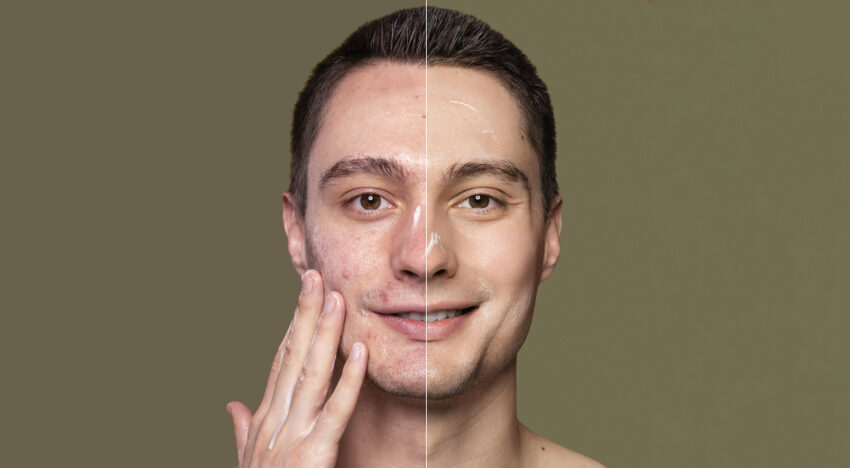
In this case, the arsenal of treatment for this complicated condition will include laser skin resurfacing and microneedle RF lifting.
◼ Laser resurfacing – fractional skin resurfacing using a CO2 laser is the gold standard among laser rejuvenation techniques. This method has been actively used in aesthetic cosmetology for over 25 years.
The procedure qualitatively rejuvenates the skin, improves its appearance, reduces the intensity of signs of aging, hides scars and stretch marks, narrows enlarged pores, evens out the topography of the skin and restores a uniform tone.
◼ Microneedle RF lifting – the procedure has a powerful lifting effect and at the same time provides skin rejuvenation and elimination of small wrinkles.
The technique works in the deep layer of the skin and affects collagen and elastin fibers, which in turn ensure skin turgor and clarity of facial contours.
You can read more about postacne and its treatment methods on our page “Treatment of postacne“.
How to restore skin after acne treatment
After eliminating this problem, the skin needs high-quality, complex care. First of all, it is a thorough cleansing and nourishment of the skin.
At an individual consultation, a dermatologist will definitely tell you how to take care of your face and body when acne is cured, in order to prevent the situation from recurring. He will also help you choose cosmetics for home care. Periodic visits to a cosmetologist as a prevention of the appearance of new acne are also highly desirable.
Why contact an Esteva Clinic specialist for acne treatment
◼ Our clinic employs experienced dermatologists who have been successfully helping our clients get rid of acne and its consequences for many years.
◼ We know how to get rid of acne and prevent the appearance of new rashes, and we will help you do it in the shortest possible time.
◼ We have all the necessary equipment for high-quality diagnosis and further treatment of skin diseases.
◼ The clinic of aesthetic medicine and cosmetology Esteva Clinic works according to a very convenient schedule – every day from 9:30 a.m. to 9:00 p.m. So telephone consultants will be able to choose a convenient day and time for you!
Консультації дерматолога
| Найменування консультації | Ціна, грн |
|---|---|
| Консультація спеціаліста | 590 |
| Повторна консультація (до 14 днів після первинної консультації до 20 хвилин) | 390 |
| Консультація спеціаліста в день проведення косметологічних процедур до (20 хвилин) | Безкоштовно |

